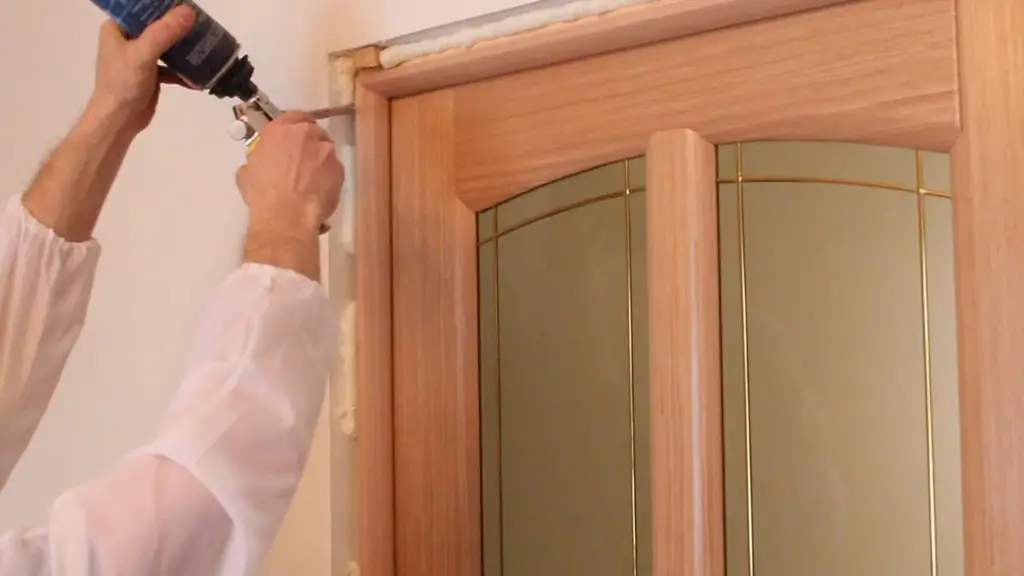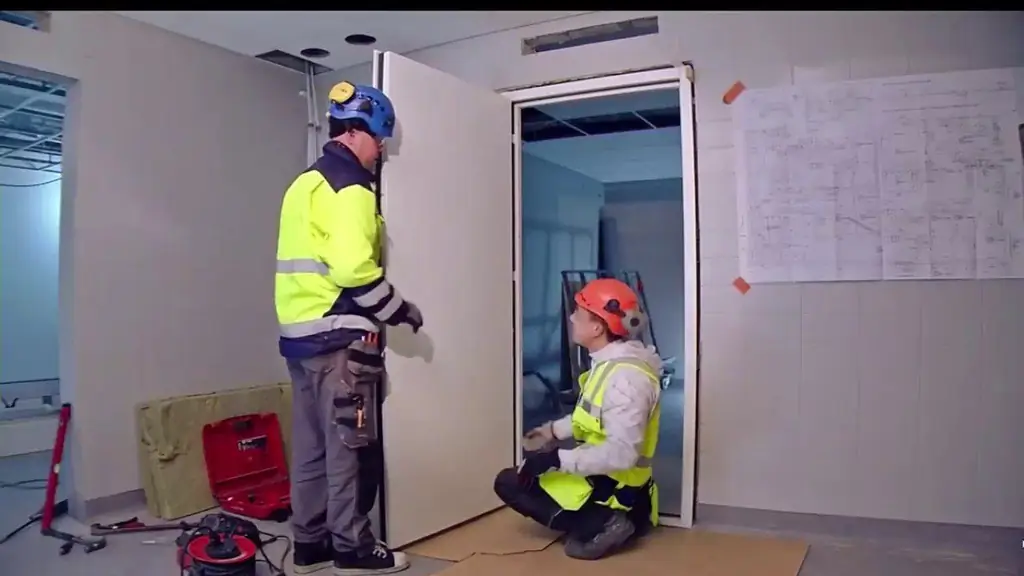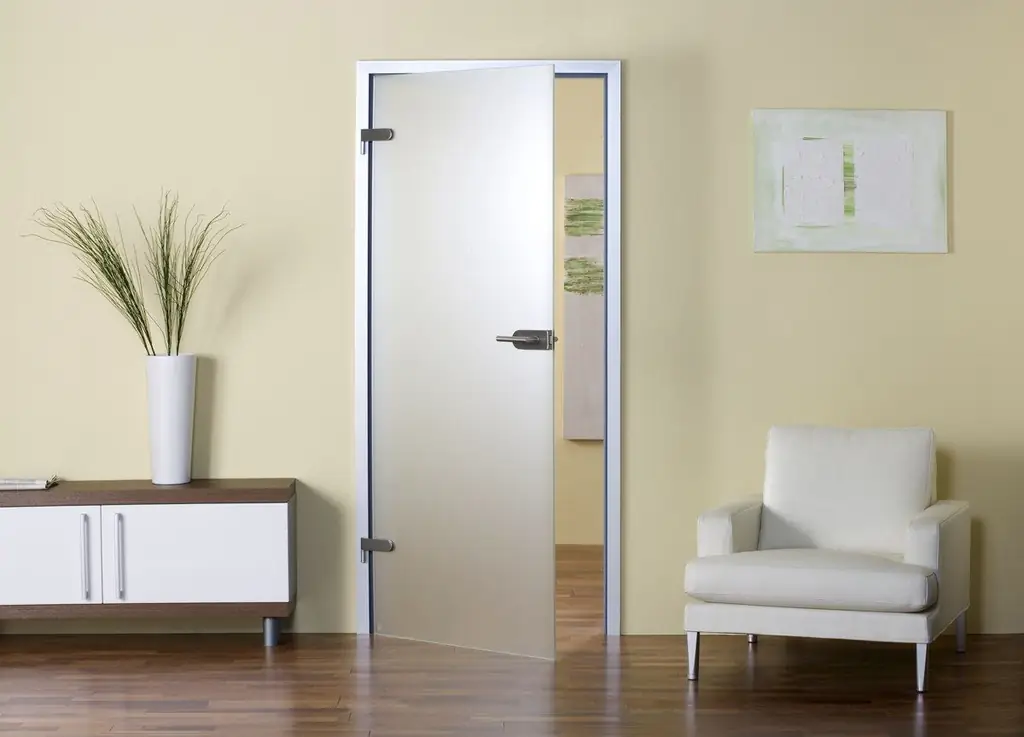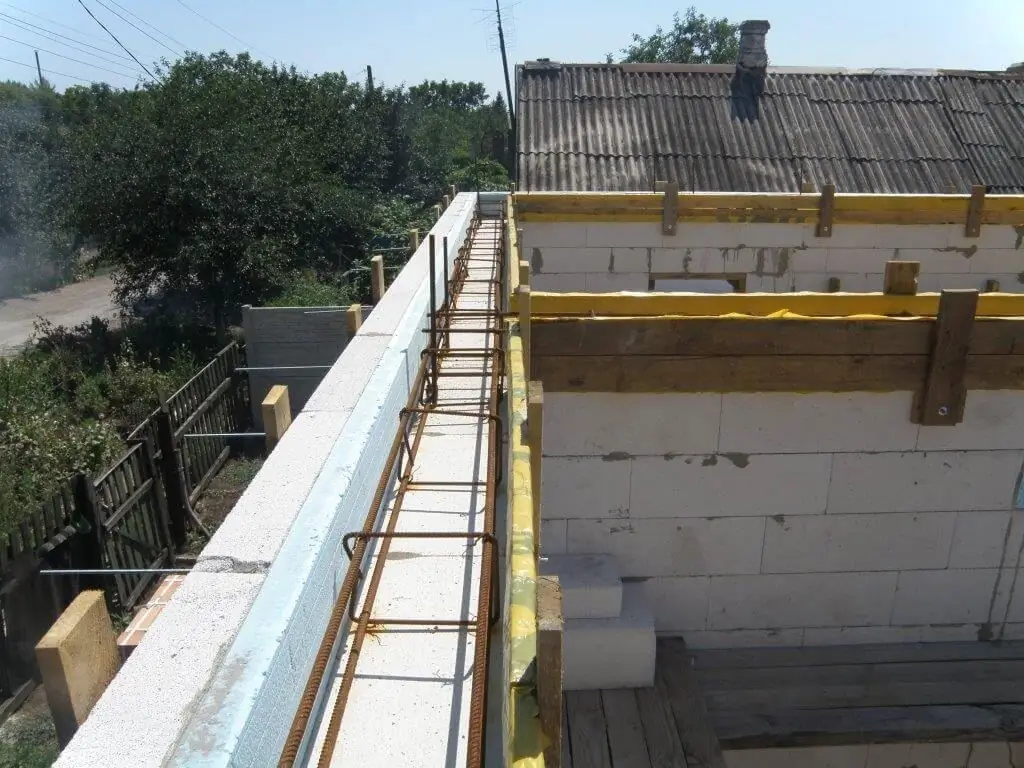
Table of contents:
- Author Bailey Albertson [email protected].
- Public 2023-12-17 12:53.
- Last modified 2025-06-01 07:32.
Installation of interior doors

Self-assembly and installation of door interroom blocks does not require high qualifications or special skills from the contractor. Consistent connection of parts in accordance with the instructions and careful installation in the doorway will allow you to get a satisfactory result even with the efforts of a beginner. You just need to stock up on the necessary tools and patience.
Content
-
1 Methods for installing interior doors
1.1 Video: fast door installation technology in 15 minutes
-
2 What is required to install an interior door
-
2.1 Required tools
- 2.1.1 What cutters are needed to install interior doors
- 2.1.2 Saw to cut the box
-
2.2 Preparing the opening for the installation of an interior door
- 2.2.1 Height
- 2.2.2 Width
- 2.2.3 Thickness (or depth) of the opening
- 2.2.4 Video: preparing the doorway before installing the interior door
-
-
3 Installing an interior door with your own hands: step by step instructions
-
3.1 Rules and procedure for installing interior doors
3.1.1 Video: how to properly install an interior door
-
3.2 Installation of double-leaf doors
3.2.1 Video: Installing a double swing door
-
3.3 Installation of interior sliding doors
3.3.1 Video: installation of interior sliding doors
-
3.4 Installation of sliding door structures
3.4.1 Video: installing sliding interior doors
- 3.5 Installation of sliding interior doors
-
3.6 Glass door installation
3.6.1 Video: Installing Glass Interior Doors
-
3.7 Installing fittings on interior doors
- 3.7.1 Work sequence
- 3.7.2 Video: inserting a lock into interior doors
-
- 4 How to check the correct installation of the interior door
- 5 Dismantling the interior door
Methods for installing interior doors
There are different ways to mount a door between rooms. It all depends on what its design is and what material the door block is made of. Its intended purpose plays a significant role in choosing a particular installation method. If this is, for example, a door to the living room, then special strength is not required. But if the door separates the walk-through corridor from the server room, in which high-sensitivity devices or units with a voltage over 1000 volts are located, then in the interests of safety, it is advisable to install a door of increased strength. Accordingly, the installation method in the second case must meet completely different requirements.
There are the following ways of fixing the door block in the opening.
-
Fixing the frame to the foam. The easiest, but not the most reliable, installation method. Suitable for lightweight MDF or MDF doors.

Foam door fastening When dry, the mounting foam firmly adheres the door frame to the wall opening
-
Installation of the door frame on the brackets. As a rule, all plastic doors (as well as windows) are mounted in this way. Metal plates are used as brackets, which are used for suspended ceilings. The thickness of the direct suspension is from 1 to 1.5 mm, so the mount is quite rigid. The main disadvantage of this method is the need to plaster the bracket attachment point. The method is applicable in the case when the walls have not yet been finished.

Direct ceiling suspension Ceiling hanger is used as a bracket to fix the door frame
-
Concealed installation, i.e. fixing the door frame under the hinges in three places. The rest of the space is filled with foam. The result is a rather durable and invisible mount. The suspension points of the frame are arranged in the following order:
- two - under the hinges;
- one - under the counter lock bar.
-
Through method. Installation is carried out using screws or anchors. Holes are drilled in the frame through which it is attached to the wall. Typically, two to four fixation points are used on each vertical post and from one to two on vertical rungs. So that the holes are not visible, they are closed from above with plastic plugs. This mount is considered the most durable and is used for heavy doors, including metal and armored.

Fixing the door to the wall opening With direct fixing, the frame is rigidly attached to the wall and can hold a heavy and powerful door
-
Fixing the door frame on the hinges. A new method developed relatively recently. Its essence lies in the fact that the box is suspended on special hinges. Anchors are installed at the ends of the opening, and metal hinges are screwed onto the frame. During installation, the hinge is put on the head of the adjustable bolt. The method is good in cases where the doorway is uneven. Installation is very fast.

Fasteners for fixing the frame on the hinges A set of simple fasteners allows you to install the door in minutes
Video: fast door installation technology in 15 minutes
What is required to install an interior door
As with any other installation work, special tools and consumables are needed to successfully install interior doors.
Required tools
Getting started with the independent installation of interior doors, you need to arm yourself with the appropriate tool:
- electric drill with a set of attachments (for screws with different slots);
-
a set of wood drills (the larger the range, the better);

Wood drill set A distinctive feature of a wood drill is a sharp tip
- perforator (in the event that the attachment is carried out on anchor devices);
-
an electric or hand-held furniture saw (the ideal option is an end circular saw);

Miter saw With the help of a miter saw, blanks for the door frame, platbands and additional elements are quickly and efficiently prepared
- drill bits or drill bits for concrete (diameter 4 and 6 mm);
-
miter box, a set of chisels of different widths;

Miter box The miter box is designed for cutting parts at different angles
-
measuring tool - hydraulic level, tape measure, square, etc.;

Measuring Construction Tools The accuracy of measurements during the assembly of interior doors affects the quality of their further operation
- knife, pencil, marker.
You will also need consumables:
-
assembly foam (plus a gun for applying it);

Polyurethane foam Foam is applied with a special assembly gun
-
self-tapping screws for wood (with a large thread pitch);

Self-tapping screws for wood Coarse thread pitch allows you to reliably fasten wood products to each other
- dowel-nails or anchor bolts;
- brackets or hinges.
What cutters are needed to install interior doors
If there is an opportunity to buy or rent a router, you should definitely use it. With a hand router, the selection of hinges and locks is greatly accelerated. There is no need for chisels, the quality of the grooves is improved. In order to optimize the process, it is desirable to use small diameter cutters. This will result in less manual cutting of wood in the corners. For example, a 9.5 mm cutter is ideal for door hinges. To cut the lock, a groove cutter of the appropriate length is used (to the depth of the insert of the locking device).

The main characteristics of a slot cutter are the height and diameter of its working part, as well as the size of the shank for the cutter clamp
Saw for cutting boxes
A few words about the electric saw. When installing one door, of course, it makes no sense to buy a "circular", especially an end one. You can use a regular hand saw with a fine (furniture) tooth.

Using a saw with fine, undisturbed teeth, you can make even and clean cuts of parts
But if there is a construction or reconstruction of an entire apartment, in which from 5 to 15 doors are installed, you can at least think about renting a tool. The quality and speed of assembly using a miter saw increases several times. Much also depends on the type of doors and platbands. Some have to be sized to fit, while others require little or no cutting.
Preparing the opening for the installation of an interior door
The main task when preparing a doorway is:
- removal of unnecessary materials from the end of the wall (residues of polyurethane foam, plaster, broken bricks, etc.);
- creating the correct geometric shape of the hole in the wall (rectangle, not trapezoid).

If the brickwork is in poor condition, it must be plastered with cement mortar.
In new buildings, doorways should theoretically have dimensions close to standard. However, in practice, this does not always happen. In a house or apartment where reconstruction is taking place, before installing new ones, you need to dismantle old doors. If at the same time the opening was damaged, it must be restored - leveled and plastered.
The installation quality of the door block is influenced by the following geometric parameters of the opening.
Height
The height is measured from the "clean floor", that is, from the level of the finishing floor covering - laminate, tiles, linoleum, etc. It is necessary that the height is the same over the entire plane. A similar requirement is imposed on the floor - there should be no bumps and pits on it, especially if the door to be installed does not contain a threshold in its design - all defects will remain in sight. The opening height should be 6-7 cm greater than the vertical dimension of the door itself.

The dimensions of the doorway must take into account the technological tolerances for the installation of the frame and the required mounting clearances.
Width
The same requirements are imposed on the opening width - it must be the same over the entire door height. Vertical planes should be at right angles to the floor and parallel. If this is not the case, the sides must be leveled. The width of the doorway is determined based on the width of the door leaf - 10 cm is added to it (5 cm on each side).
The thickness (or depth) of the opening
An important condition that must be observed when preparing the opening is that the end must be rectangular. In the lower part, at the point of intersection with the floor, a right angle (90 °) should form. If the thickness of the walls is not the same, gaps will form under the platbands, which, in fact, is a marriage.
Video: preparing a doorway before installing an interior door
DIY interior door installation: step by step instructions
Since the overwhelming majority of doors in the surrounding life have a swing structure, we will consider the installation procedure using the example of a typical interior door.

The most common type of interior doors has a swing opening mechanism.
Rules and procedure for installing interior doors
Installation of a swing interior door is carried out in the following order.
-
Development of a door frame fastening scheme in the opening. At this stage, it is necessary to clearly imagine (or better sketch) the method of fastening. In our case, it will be fixing with screws and polyurethane foam. It is also necessary to decide on the side to which the door will open. If there is no previously thought out plan, the following hint will help to solve the problem: it is customary to open the door in small rooms, such as a toilet, a pantry and a bath. It is better to go outside into corridors from large rooms.

Door frame fixing scheme The most common way of fixing the frame in the doorway is installation by means of anchoring on foam.
-
Installation of the door frame. It is advisable to place the door that arrived from the store on a flat horizontal surface - a table, chairs or on the floor and unpack it. Assembly is carried out using self-tapping screws for wood with a thickness of 3.5 mm. Before screwing in the self-tapping screw, it is necessary to drill a hole that will not allow the wood blank (fiberboard, MDF, chipboard) to split. A drill with a smaller diameter is used, in particular 3 mm. For the same reasons, it is not necessary to screw the screws close to the edge of the parts - the standard distance is at least 5 diameters, that is, 1.5 cm. To securely fasten the horizontal slats of the door frame, four screws are enough - two on each side.

Assembling the door frame When assembling the frame on the floor, put cardboard from the packaging under the box
-
Undercutting of racks. Usually the door frame is sold with a 5-7 cm margin. After fixing the side parts, you need to measure the exact size and cut off the excess. For this, the height of the opening is measured and transferred to the frame. It should be borne in mind that a technological gap of 2-2.5 cm must remain between the box and the wall. Such a backlash is needed so that the frame can be aligned horizontally and vertically inside the opening.

Undercutting the sidewalls of the door frame The adjustment of the length of the side posts is carried out after measuring the height of the opening
-
Installation of the frame in the doorway. If up to this point the door leaf was inside the frame, then to install the frame in the wall, the sash must be removed. The frame is installed in the designated place and leveled using a level. Primary fixation is carried out with plastic or wooden wedges. It is very convenient to use a set of thin wedges, with their help, you can accurately align the box on all axes. It should be remembered that the racks of the box must be vertical in two perpendicular planes - from the side of the canvas and from the side of the wall. The correct operation of the door block is 80% dependent on the correct position of the door frame. In a number of models of interior doors there is a special decorative strip, which is disconnected and fastening holes are drilled under it. At the end of the installation, the bar is put in place. To secure the frame with screws,you need to drill 3-4 holes with a diameter of 4 mm on each stand and transfer them with a pencil or marker to the wall. After that, the box is removed and nests for dowels are drilled in the wall according to the markings. Remember that wood drills do not work in concrete. The brickwork is drilled with a perforator with a drill on the stone. The drill diameter is 6 mm, the size of the plastic sleeve. When the holes are ready and the dowels are inserted into the wall, the frame returns to its original position and is preliminarily fixed (it is "cured", as the craftsmen say). Before the final tightening of the screws, the position of the vertical and horizontal parts of the box is checked again. The tightening is carried out in a circle, first the screws are tightened half-way, then - with maximum effort. In order not to overtighten the fasteners,during tightening, the verticality of the racks is checked with a long two-meter level or rule.

The procedure for installing the frame in the doorway The use of a construction laser level improves the accuracy of the door frame installation
-
Installation of the door leaf on the hinges. Since we are considering a light interior door made of MDF or fiberboard, one person can hang the sash on the hinges. It is enough to raise the door above the awnings and carefully put it on the hinge axis. After that, the door leaf must be closed and its location checked. If the door is mounted in compliance with all technological standards (gaps of 3-4 mm on each side), it will move inside the frame easily and without human effort. In the open state, the sash will not spontaneously slam, and in the closed state it will not open. If there are no hinge recesses in the purchased door, you need to make them yourself. To do this, a milling cutter is inserted into the tool, the depth of immersion in the wood is adjusted and the groove is selected with a translational movement according to a previously marked size. The accepted location of the hinges is 20-25 cm from the upper and lower edge of the sash.

Installation of door hinges The hinges are placed above and below at the same distance from the edges of the door leaf
-
Joint filling with polyurethane foam. This is a crucial moment, since such important parameters of the door as sound insulation and heat resistance depend on the density of the filling. It is better to use polyurethane foam with a low expansion coefficient. To accelerate the setting and solidification of polyurethane, the walls and door frame are moistened with water (sprayed from a spray bottle). Filling is carried out sequentially, from bottom to top, so that no voids remain, but the foam flakes do not fall on the floor. It is advisable to cover the door with foil during the operation, since prolonged contact with polyurethane can cause stains on the laminated surface. As it dries, the foam increases in volume, so the seams are initially filled by 30-40%. After complete solidification (after 24 hours at an air temperature of 20 oC) the excess is trimmed with a sharp knife. It is not recommended to open the door leaf during foaming and drying. It is advisable to put pieces of packaging cardboard into the gaps (around the perimeter). This will prevent the frame from warping and sagging in case there is too much foam.

Foam filling It is better to fill the mounting gaps with foam from the bottom up, carefully processing the voids
-
Doorway decoration. Upon completion of the installation of the door, it is necessary to fix the opening. For this, slopes or platbands are installed in it. For interior doors, trimming with slopes is rarely done (although this is also practiced, depending on the place of installation and the function of the door). The most common type of decoration is platbands and extensions. If the size of the wall is small and the width of the door frame coincides with it, platbands are installed on both sides and the finishing of the opening ends there. If the width of the box is not enough to cover the wall completely, add-ons are used. With their help, the plane of the frame expands, and the platbands are no longer attached to the box, but to the extensions. Interestingly, designers sometimes deliberately choose the colors of the complements that contrast with the color of the door. Such solutions are original in nature and emphasize the door as an element of the interior. Platbands are installed in several ways, depending on their design:
- groove connection;
- by gluing to the wall;
- hidden nails.
-
Installation of fittings. A doorknob and lock are usually included with the door. Or at least the mounting holes are prepared in the canvas. If they are not there, you need to mark the sash and use a router and an electric drill to cut holes of the required size (for previously purchased accessories). This should be guided by the instructions for installing the lock and door handle, which are attached to the products. The approximate installation height of the door lock is 90-110 cm from the floor. The handle is mounted at the same height, stepping back 10-15 cm from the edge of the door leaf.

Installing a door lock The method of installing a door lock depends on its design, but it is usually located at a height of 90-110 cm from the floor
The type of connection between vertical and horizontal platbands can be different - rectangular or diagonal. From a mounting point of view, a rectangular connection is considered simpler. For diagonal seam is important to make an accurate cutting of workpieces 45 on. For this, craftsmen use a circular saw. But with small volumes, you can also use a carpentry miter box.

The diagonal connection of platbands requires a perfectly flat cut at an angle of 45 degrees, which is carried out using a miter box or circular saw
Video: how to properly install an interior door
Installation of double doors
Double-leaf door blocks are a popular interior decoration. They fit especially harmoniously into wide doorways and emphasize the spaciousness of the room. Doors with two leaves are:
-
hinged (sashes rotate around the axis);

Swing double-leaf doors The door leaf is opened by turning around the vertical axis
-
sliding (door leaves move apart in different directions).

Sliding double doors The door is opened by moving the sash horizontally
When assembling double-leaf swing doors, the algorithm remains the same as for a single-leaf door. But there is one nuance associated with the door suspension. The first is a sash with a latch, which is cut ahead of time into the upper part of the canvas, on the hinges. After installing the sash on the hinges, fix it with a latch and proceed to the installation of the other half of the door. Thus, the alignment of the canvases in relation to the frame and among themselves is achieved. The gaps adopted for a single-leaf door are also relevant for a double-leaf version.

Espagnolette keeps the door leaf in a fixed position
The sliding design of double-leaf doors differs in that it does not have a frame in the usual sense. The door leaves are supported by a suspended profile equipped with a rocker mechanism. Naturally, the installation of such a door differs from the assembly of swing structures. Installation is carried out on straight walls with sufficient space (you need space for opening doors).

Around the sliding door, you need to provide a free space for those leaving when opening the racks
Installation begins with the assembly and fastening of the guide profiles (which can be either above or below the doorway). Further, the procedure must be carried out in this sequence.
-
Fastening brackets with fittings (carriages and movable rollers) to the canvas.

Installation diagram of sliding doors A diagram of fastening the door leaf to the rocker mechanism indicating the mass of the door leaf is attached to each product
- Installation of sashes on the suspension mechanism.
-
Fastening of stoppers (rubber stops for opening the sash).

Sliding door stopper With the help of the limiter, the free movement of the door leaf is adjusted to protect it from impacts against nearby objects and surfaces
- Installation of accessories and platbands on the doorway.
- Installation of additional door hardware (brushes, seals, grips).
At the preparatory stage, the wall plane is marked and aligned. This is important because the door leaves are constantly moving along the walls.
The main document that you need to read when installing sliding doors is the assembly instructions from the manufacturer. It reflects the technical requirements for installation and basic operating rules.
Video: installing a double swing door
Installation of interior sliding doors
Sliding door is one of the options for sliding interior doors. In contrast to the two-leaf design, the interior compartment door can be single-leaf, three-leaf, and even four-leaf. Moreover, one or two canvases can move at the same time. Installation is carried out in the same order as for a sliding door in accordance with the manufacturer's instructions.

Sliding doors save space in small spaces
Video: installation of interior sliding doors
Installation of sliding door structures
A characteristic feature of sliding interior doors is the movement of the door leaf along the supporting profile located on the floor. Installation is carried out after finishing the floor. The guide profile is installed in parquet, laminate, ceramic tiles or other floor coverings. Often, the door leaf is hidden in a wall cavity specially prepared for this.

Before installing the sliding door, a false wall is built to hide the sash
There are options for the manufacture of false walls or drywall boxes for sliding interior doors. But in any case, the suspension mechanism remains the same as for all other types of sliding doors.
Video: installing sliding interior doors
Installation of sliding interior doors
Sliding interior doors save space in small spaces. But for their installation, certain conditions are needed, the main of which is the availability of space for moving the door leaf. Sliding doors can be single-leaf or double-leaf. The supporting rocker mechanism is located, as a rule, on top, and a limiting profile is mounted from below, which does not allow the canvas to swing while moving.

When planning, various options for the location of the leaf in the doorway are used
Glass door installation
Glass doors are a very original solution for interior decoration. Like doors made of other materials, they are swing and sliding. In private housing construction, swing-type glass doors are commonly used. In general, the principle and order of their installation does not differ from the standard, however, there are several features.
- The glass door leaf cannot be adjusted to the dimensions, it cannot be sawed or cut. Therefore, in order to avoid mistakes, the doors are ordered after finishing the walls and doorway (when the dimensions will not change).
- Door installation is not done alone. The weight of the glass sheet is usually from 50 to 70 kg, it is difficult and dangerous to manipulate such a sash for one person.
- A glass interior door is mounted on a wooden or metal frame.
- The durability of glass doors is limited only by the durability of the hinges. Pendulum loops are considered the most reliable.

To assemble the suspension of glass doors, mounting holes are cut in the door leaf at the factory.
The hinge holes are cut at the glass door manufacturer. You need to drill holes for the lock and handle yourself using a glass drill of the required diameter.

Holes in the glass are drilled with special drills at low speeds
The advantage of glass interior doors is their almost unlimited service life. Their appearance is not subject to mechanical or chemical stress, the strength of the glass block is comparable to the strength of metal. The only thing you need to watch out for is the safety of the hinges and fittings. Timely lubrication and removal of contamination are two prerequisites for the long-term operation of glass interior doors.
Video: installing glass interior doors
Installation of fittings on interior doors
Installation of fittings is perhaps the most crucial moment in the installation of interior doors. It is during this part of the work that errors occur, leading to quick breakdowns. Therefore, getting down to self-installation, you need to tune in to painstaking "jewelry" work. Mistakes are too expensive.
So, accessories include:
-
door hinges of various types and designs;

Types of door hinges The design of the door hinges affects the way they are installed
- door locks (overhead and mortise);
- door handles (there are rotary and stationary);
-
latches;

Types of door latches A variety of door hardware helps to decorate any interior door
- door rollers (in sliding, sliding and sliding doors).
All hardware elements require precise cutting into the plane of the door leaf or frame, and this presents a certain difficulty for novice carpenters. The permissible error must not be exceeded by more than 1 mm. Otherwise, there are no firm guarantees for the stable operation of the mechanisms.
Sampling is done manually (with chisels) or using a power tool. At this stage of the work, a manual electric router is used.

Working at high rpm, the router makes neat and clean cuts in wood
Sequence of work
The installation of fittings on a swing door is carried out in the following order.
-
Markup. Before you start cutting the hole, you need to determine the location of the hinges. As noted above, in order to evenly distribute the weight of the door leaf, the hinges are arranged symmetrically 20-25 cm from the edges of the door leaf. The contours of the loop are drawn with a sharp pencil and traced around the perimeter with a knife, scalpel or semicircular chisel.

Insert door hinges It is advisable to outline the contour of the loop with a sharp pencil, thin awl or scalpel
-
Hinge seat device. A chisel makes a gradual selection of wood from the outlined contour. It is necessary to control the groove depth within 2-3 mm. The accuracy of the cut is checked with a hinge - when it is placed in the prescribed place, the front part of the fittings must coincide with the surface of the door end. When sampling for hinges in MDF doors, the manual method is ineffective, it is advisable to use a router with a small diameter cutter.

Fixing door hinges The hinges should be flush with the surface of the canvas
- Preparation of recesses in the frame. Having made the grooves and installing the hinges in them, they proceed to the manufacture of similar seats in the door frame.
-
Installation of an interior door handle. The operation consists in cutting out a seat for the lock and holes for installing a rotary handle. It is difficult to do without a router here, especially for a person who does not have carpentry experience. Using a long cutter, a groove of a certain depth for the lock is selected. A small cutter is used to cut out a sweep for the lock plate and striker. To pinpoint the location of the locking tongue, it is smeared with a dye (nail polish, chalk, paint) and released onto the frame. In the designated place, the hole of the striker is installed.

Door lock insert The grooves for the door lock are made using a router
- Installing the bolt. It is carried out depending on the design of the locking element. As a rule, the installation of a high-quality bolt involves sampling a masking groove. The device is applied to the edge of the door leaf, its shape is outlined and a groove is cut along it.
Video: inserting a lock into interior doors
How to check the correct installation of an interior door
Anyone who has to install internal doors for the first time asks questions: is the door installed correctly and what needs to be done to make it work for a long time and properly. They have a comprehensive answer, which consists of two points.
- A sign of a correctly carried out installation is the same technological gaps along the perimeter of the entire web. This means that if the gap around the sash is the same size everywhere, the curtain is hung correctly.
- The door has to pass a little test. When opening (and closing) the canvas, no extraneous sounds, creaks, rustles (friction of one surface against another) should be heard. At the same time, the sash moves easily, without any effort. If the hand stops, the canvas also stops, it should not move on its own.
If these two conditions are met, the door is assembled in accordance with technical and operational standards.
Dismantling an interior door
Often the installation of an interior door is preceded by dismantling. Disassembly is carried out in the reverse order of assembly.
-
Decor elements - platbands and extensions are detached. In this case, use a pry bar or a large screwdriver. The decorative elements can be reused, so do not break them during dismantling. If these parts are kept intact, they can be painted, covered with laminated film and used when installing a new door.

Dismantling an interior door Platbands are removed using a pry bar or an ax
- The hardware is removed from the door leaf - locks and handles. The lock is unscrewed from the end of the door leaf. The swing handle mount is located on one side of the door (at the bottom of the lever).
-
The door leaf is removed. To do this, the sash is opened at an angle of 90 o in relation to the frame and lifted by the bottom edge using a crowbar, pry bar or other lever. Once the canvas is removed from the hinges, the awnings can be detached and reused.

Dismantling the canvas To remove the canvas from the hinges, turn it at an angle of 90 degrees and raise it using a lever
-
The door frame is removed. To disassemble the frame with the least effort, it is necessary to determine the places of its fixation to the wall. Sometimes it is difficult to do this in old doors, especially if slopes made of cement mortar are installed on the opening. Then an ordinary electric jigsaw will come to the rescue. If the frame is not planned to be used in the future, it can be cut in cross-section and separated from the wall in parts. This greatly speeds up the dismantling process. The upper crossbar is released in the same way.

Dismantling the door frame Using a power tool, the dismantling of doors is accelerated several times
If there is no firm self-confidence, of course, it is better to turn to professional installers, because the correct assembly and installation is not the only, but a necessary condition for the long-term operation of interior doors. But if you have at least a little experience in carpentry work, and the operations described in this article do not cause you to doubt the possibility of repeating them, feel free to start installing the door with your own hands. You can save money and be absolutely confident in the quality of each action.
Recommended:
Potato Storage: How To Properly Carry Out At Home, The Required Temperature, Including In The Winter On The Balcony Of The Apartment

How and where to store potatoes. Container for storage at home. Is it possible on the balcony. Errors
Installation Of Fire Doors: How To Properly Carry Out The Installation And What Regulatory Documents Must Be Followed

Fire doors installation technology, for which premises they are suitable. Features of service and repair
Making Glass Doors, As Well As How To Install Them Correctly And What Tools Are Required To Carry Out The Work

Self-manufacturing technology of glass doors. How to install, adjust, dismantle them correctly. What tools can be used
Armopoyas For Mauerlat And Its Purpose, As Well As How To Properly Carry Out Installation Work

Armopoyas functions and its main parameters. How to make your own concrete mix. Instructions for the construction of an armored belt and attaching a Mauerlat to it
Gable Trim, Including Which Material To Choose, As Well As How To Carry Out The Work Correctly

The structure, types and purpose of the pediment. Why do we need a pediment facing? Materials used for cladding. Necessary tools and stages of work
